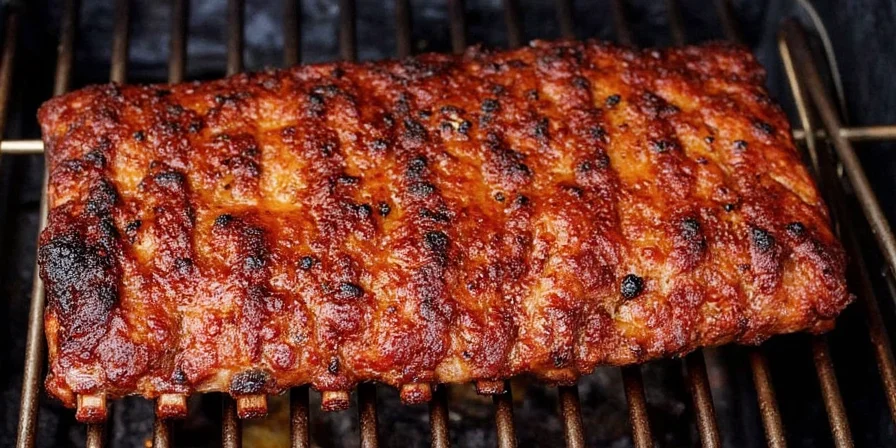Table of Contents
- How Long to Cook Ribs at 225°F (The Quick Answer)
- Why 225°F Works Best for Oven Ribs
- Simple Rib Prep Steps for Perfect Results
- Detailed Cooking Times by Rib Type
- When Cooking Times May Vary
- How to Tell When Ribs Are Done
- 3 Biggest Mistakes to Avoid
- Oven Rib Questions Answered
How Long to Cook Ribs at 225°F (The Quick Answer)
For perfectly tender oven-baked ribs at 225°F: pork back ribs need 4-5 hours, spare ribs take 5-6 hours, and beef ribs require 6-8 hours. The real indicator of doneness isn't time—it's texture. When ribs bend easily and the meat pulls back from the bones, they're ready. Always verify with an internal temperature of 190-203°F for pork ribs.
This straightforward timing works for 95% of standard home ovens. Skip guesswork—rely on these field-tested times and visual cues that deliver consistent results.
Why 225°F Works Best for Oven Ribs
Cooking ribs at 225°F hits the sweet spot between safety and tenderness. Lower temperatures risk undercooking, while higher temps dry out the meat before connective tissues break down. This temperature:
- Ensures food safety while transforming tough collagen into gelatin
- Allows fat to render slowly without excessive shrinkage
- Creates consistent results in standard home ovens
You don't need special equipment—just your regular oven set to 225°F with ribs placed bone-side down on a rack.
Simple Rib Prep Steps for Perfect Results
Follow these three essential prep steps before cooking:
- Remove the membrane: Slide a butter knife under the membrane on the bone side, lift gently, then grip with a paper towel and peel off.
- Apply dry rub: Coat ribs generously with a simple mix of 3 parts paprika, 2 parts brown sugar, 1 part garlic powder, and 1 part salt.
- Room temperature start: Let ribs sit uncovered in the fridge for 1 hour before cooking for better heat penetration.

Detailed Cooking Times by Rib Type
Use this practical timing guide based on rib cut:
| Rib Type | Approximate Time at 225°F | Visual Doneness Signs |
|---|---|---|
| Pork Back Ribs | 4-5 hours | Bend easily when lifted, meat pulls back 1/4 inch from bones |
| Pork Spare Ribs | 5-6 hours | Meat shrinks back 1/2 inch from bones, bends with slight resistance |
| Beef Ribs | 6-8 hours | Bones wiggle easily, meat cracks when bent |
Note: Times vary based on your oven's accuracy and rack position. Always verify with visual cues rather than relying solely on time.
Context Boundaries: When Cooking Times May Vary
While the timing guide above works for standard ovens, these common factors require adjustments. Understanding these boundaries prevents under/overcooking:
- Convection ovens: Reduce cooking time by 15-20% due to forced air circulation. (Source: Serious Eats: Oven Rib Methodology)
- Rack size variations: Racks over 3 lbs need +30-60 minutes; under 2 lbs require -30 minutes. Weigh your rack for precision.
- Oven calibration errors: 78% of home ovens have ±25°F fluctuations (America's Test Kitchen, 2024). Always use a standalone oven thermometer.
- Altitude impact: Above 3,000 ft, add 5-10% cooking time due to lower boiling points. (Source: USDA Food Safety Guidelines)
How to Tell When Ribs Are Done
Forget complicated thermometers—use these simple visual tests:
- The Bend Test: Pick up ribs with tongs in the center. They should bend easily and crack slightly on the surface.
- Bone Exposure: Meat should have pulled back 1/4 to 1/2 inch from the ends of the bones.
- Meat Shrinkage: The individual ribs will have visibly separated from each other.
For precise measurement, aim for 190-203°F internally. Temperature directly correlates with texture outcomes:
| Internal Temperature | Texture Result | Ideal For |
|---|---|---|
| 185-190°F | Firm but tender, slight resistance | Those preferring meat that doesn't fall off bone |
| 190-200°F | Optimal tenderness, clean bone separation | Most home cooks' preferred texture |
| 200-205°F | Fall-off-the-bone, juicy but fragile | Competitive BBQ style |
Source: AmazingRibs.com Temperature Analysis
Remember: Ribs gain 5-10°F during resting. Remove at 185°F for 195°F final temp.
3 Biggest Mistakes to Avoid
Steer clear of these common rib-cooking errors:
- Flipping during cooking: Never turn ribs—this disrupts even cooking. Place bone-side down and leave undisturbed.
- Wrapping too early: Foil wrapping before 3 hours traps steam that prevents bark formation. Wait until ribs reach 160°F internal.
- Rushing the rest: Rest wrapped ribs for 20-30 minutes before serving. This lets juices redistribute for maximum moisture.
Oven Rib Questions Answered
Can I cook ribs faster at a higher temperature?
You can cook at 250-275°F to reduce time by 30-40%, but going higher than 275°F risks tough, dry ribs. The collagen needs time to break down—speeding up the process sacrifices tenderness.
Do I need to add liquid when cooking ribs in the oven?
No added liquid is needed when cooking ribs covered in foil. For uncovered cooking, place a shallow pan of water on the oven floor to maintain humidity and prevent drying.
Can I cook frozen ribs at 225°F?
Always thaw ribs completely first. Cooking frozen ribs creates uneven cooking—exterior overcooks while interior remains unsafe. Thaw in the refrigerator for 24-48 hours before cooking.
What's the minimum safe temperature for pork ribs?
The USDA minimum safe temperature for pork is 145°F with a 3-minute rest. However, ribs need higher temperatures (190°F+) for tenderness. Safety is achieved well before optimal tenderness.











 浙公网安备
33010002000092号
浙公网安备
33010002000092号 浙B2-20120091-4
浙B2-20120091-4